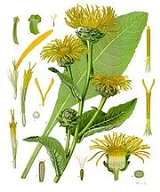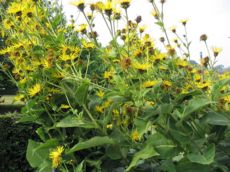
Elecampane
Encyclopedia
Elecampane, also called Horse-heal (Inula helenium) or Marchalan (in Welsh
), is a perennial
composite plant common in many parts of Great Britain
, and ranges throughout central and Southern Europe
, and in Asia
as far eastwards as the Himalayas
.
It is a rather rigid herb
, the stem
of which attains a height of from 3 to 5 feet; the leaves
are large and toothed, the lower ones stalked, the rest embracing the stem; the flower
s are yellow, 2 inches broad, and have many rays, each three-notched at the extremity. The root is thick, branching and mucilaginous, and has a warm, bitter taste and a camphoraceous odor
with sweet floral (similar to violet) undertones.
In France
and Switzerland
it is used in the manufacture of absinthe
.
(C6H12O6[C6H10O5]n), a body isomeric with starch
, the root
contains helenin (C15H20O2), a stearoptene, which may be prepared in white acicular crystal
s, insoluble in water, but freely soluble in alcohol
. When freed from the accompanying inula-camphor by repeated crystallization from alcohol, helenin melts at 110 °C.
(CIT), Ireland, has shown that extracts from the herb kill methicillin-resistant Staphylococcus aureus
(MRSA) as well as a broad spectrum of other bacteria
.
 The plant's specific name, helenium, derives from Helen of Troy; elecampane is said to have sprung up from where her tears fell. It was sacred to the ancient Celts, and once had the name "elfwort".
The plant's specific name, helenium, derives from Helen of Troy; elecampane is said to have sprung up from where her tears fell. It was sacred to the ancient Celts, and once had the name "elfwort".
, and in England
it was formerly in great repute as an aromatic tonic and stimulant of the secretory organ
s. As a drug, however, the root is now seldom resorted to except in veterinary practice.
John Gerard
recommended elecampane for "the shortness of breath"; today herbalists prescribe it as an expectorant and for water retention
. It has minor applications as a tonic and to bring on menstruation
.
Elecamane from Grieve
, A Modern Herbalhttp://www.botanical.com/botanical/mgmh/e/elecam07.html
Welsh language
Welsh is a member of the Brythonic branch of the Celtic languages spoken natively in Wales, by some along the Welsh border in England, and in Y Wladfa...
), is a perennial
Perennial plant
A perennial plant or simply perennial is a plant that lives for more than two years. The term is often used to differentiate a plant from shorter lived annuals and biennials. The term is sometimes misused by commercial gardeners or horticulturalists to describe only herbaceous perennials...
composite plant common in many parts of Great Britain
Great Britain
Great Britain or Britain is an island situated to the northwest of Continental Europe. It is the ninth largest island in the world, and the largest European island, as well as the largest of the British Isles...
, and ranges throughout central and Southern Europe
Southern Europe
The term Southern Europe, at its most general definition, is used to mean "all countries in the south of Europe". However, the concept, at different times, has had different meanings, providing additional political, linguistic and cultural context to the definition in addition to the typical...
, and in Asia
Asia
Asia is the world's largest and most populous continent, located primarily in the eastern and northern hemispheres. It covers 8.7% of the Earth's total surface area and with approximately 3.879 billion people, it hosts 60% of the world's current human population...
as far eastwards as the Himalayas
Himalayas
The Himalaya Range or Himalaya Mountains Sanskrit: Devanagari: हिमालय, literally "abode of snow"), usually called the Himalayas or Himalaya for short, is a mountain range in Asia, separating the Indian subcontinent from the Tibetan Plateau...
.
It is a rather rigid herb
Herb
Except in botanical usage, an herb is "any plant with leaves, seeds, or flowers used for flavoring, food, medicine, or perfume" or "a part of such a plant as used in cooking"...
, the stem
Plant stem
A stem is one of two main structural axes of a vascular plant. The stem is normally divided into nodes and internodes, the nodes hold buds which grow into one or more leaves, inflorescence , conifer cones, roots, other stems etc. The internodes distance one node from another...
of which attains a height of from 3 to 5 feet; the leaves
Leaves
-History:Vocalist Arnar Gudjonsson was formerly the guitarist with Mower, and he was joined by Hallur Hallsson , Arnar Ólafsson , Bjarni Grímsson , and Andri Ásgrímsson . Late in 2001 they played with Emiliana Torrini and drew early praise from the New York Times...
are large and toothed, the lower ones stalked, the rest embracing the stem; the flower
Flower
A flower, sometimes known as a bloom or blossom, is the reproductive structure found in flowering plants . The biological function of a flower is to effect reproduction, usually by providing a mechanism for the union of sperm with eggs...
s are yellow, 2 inches broad, and have many rays, each three-notched at the extremity. The root is thick, branching and mucilaginous, and has a warm, bitter taste and a camphoraceous odor
Odor
An odor or odour is caused by one or more volatilized chemical compounds, generally at a very low concentration, that humans or other animals perceive by the sense of olfaction. Odors are also commonly called scents, which can refer to both pleasant and unpleasant odors...
with sweet floral (similar to violet) undertones.
In France
France
The French Republic , The French Republic , The French Republic , (commonly known as France , is a unitary semi-presidential republic in Western Europe with several overseas territories and islands located on other continents and in the Indian, Pacific, and Atlantic oceans. Metropolitan France...
and Switzerland
Switzerland
Switzerland name of one of the Swiss cantons. ; ; ; or ), in its full name the Swiss Confederation , is a federal republic consisting of 26 cantons, with Bern as the seat of the federal authorities. The country is situated in Western Europe,Or Central Europe depending on the definition....
it is used in the manufacture of absinthe
Absinthe
Absinthe is historically described as a distilled, highly alcoholic beverage. It is an anise-flavoured spirit derived from herbs, including the flowers and leaves of the herb Artemisia absinthium, commonly referred to as "grande wormwood", together with green anise and sweet fennel...
.
Medical use
For medicinal purposes, the roots should be procured from plants not more than two or three years old. Besides inulinInulin
Inulins are a group of naturally occurring polysaccharides produced by many types of plants. They belong to a class of fibers known as fructans. Inulin is used by some plants as a means of storing energy and is typically found in roots or rhizomes...
(C6H12O6[C6H10O5]n), a body isomeric with starch
Starch
Starch or amylum is a carbohydrate consisting of a large number of glucose units joined together by glycosidic bonds. This polysaccharide is produced by all green plants as an energy store...
, the root
Root
In vascular plants, the root is the organ of a plant that typically lies below the surface of the soil. This is not always the case, however, since a root can also be aerial or aerating . Furthermore, a stem normally occurring below ground is not exceptional either...
contains helenin (C15H20O2), a stearoptene, which may be prepared in white acicular crystal
Crystal
A crystal or crystalline solid is a solid material whose constituent atoms, molecules, or ions are arranged in an orderly repeating pattern extending in all three spatial dimensions. The scientific study of crystals and crystal formation is known as crystallography...
s, insoluble in water, but freely soluble in alcohol
Alcohol
In chemistry, an alcohol is an organic compound in which the hydroxy functional group is bound to a carbon atom. In particular, this carbon center should be saturated, having single bonds to three other atoms....
. When freed from the accompanying inula-camphor by repeated crystallization from alcohol, helenin melts at 110 °C.
Recent science
Susan O'Shea, a research student at Cork Institute of TechnologyCork Institute of Technology
Cork Institute of Technology , formerly the Regional Technical College, Cork, is an Institute of Technology in Ireland, located in Cork, Ireland opened in 1973. The institute has 17,000 students in art, business, engineering, music and science disciplines...
(CIT), Ireland, has shown that extracts from the herb kill methicillin-resistant Staphylococcus aureus
Methicillin-resistant Staphylococcus aureus
Methicillin-resistant Staphylococcus aureus is a bacterium responsible for several difficult-to-treat infections in humans. It is also called multidrug-resistant Staphylococcus aureus and oxacillin-resistant Staphylococcus aureus...
(MRSA) as well as a broad spectrum of other bacteria
Bacteria
Bacteria are a large domain of prokaryotic microorganisms. Typically a few micrometres in length, bacteria have a wide range of shapes, ranging from spheres to rods and spirals...
.
Folklore

Herbalism
The root was employed by the ancients, mentioned in Pliny, Natural History 19.29 both as a medicine and as a condimentCondiment
A condiment is an edible substance, such as sauce or seasoning, added to food to impart a particular flavor, enhance its flavor, or in some cultures, to complement the dish. Many condiments are available packaged in single-serving sachets , like mustard or ketchup, particularly when supplied with...
, and in England
England
England is a country that is part of the United Kingdom. It shares land borders with Scotland to the north and Wales to the west; the Irish Sea is to the north west, the Celtic Sea to the south west, with the North Sea to the east and the English Channel to the south separating it from continental...
it was formerly in great repute as an aromatic tonic and stimulant of the secretory organ
Organ (anatomy)
In biology, an organ is a collection of tissues joined in structural unit to serve a common function. Usually there is a main tissue and sporadic tissues . The main tissue is the one that is unique for the specific organ. For example, main tissue in the heart is the myocardium, while sporadic are...
s. As a drug, however, the root is now seldom resorted to except in veterinary practice.
John Gerard
John Gerard
John Gerard aka John Gerarde was an English herbalist notable for his herbal garden and botany writing. In 1597 he published a large and heavily illustrated "Herball, or Generall Historie of Plantes", which went on to be the most widely circulated botany book in English in the 17th century...
recommended elecampane for "the shortness of breath"; today herbalists prescribe it as an expectorant and for water retention
Water retention
Water retention can refer to:*Water retention , an abnormal accumulation of fluid in the circulatory system or within the tissues or cavities of the body...
. It has minor applications as a tonic and to bring on menstruation
Menstruation
Menstruation is the shedding of the uterine lining . It occurs on a regular basis in sexually reproductive-age females of certain mammal species. This article focuses on human menstruation.-Overview:...
.
External links
Elecampane at Plants for a FutureElecamane from Grieve
Maud Grieve
Sophia Emma Magdalene Grieve was the Principal and Founder of The Whins Medicinal and Commercial Herb School and Farm at Chalfont St. Peter in Buckinghamshire, England. Maud Grieve was a Fellow of the Royal Horticultural Society with an encyclopedic knowledge of medicinal plants...
, A Modern Herbalhttp://www.botanical.com/botanical/mgmh/e/elecam07.html

